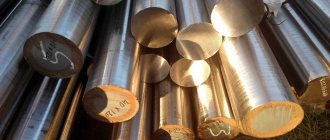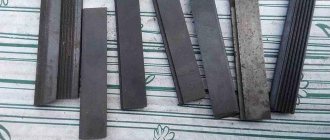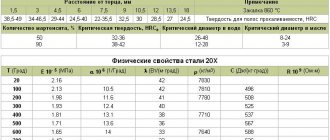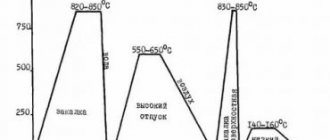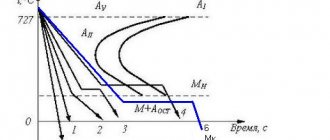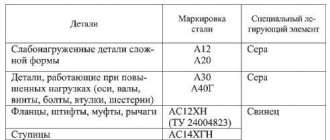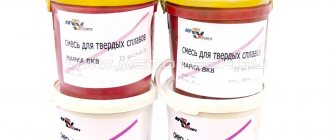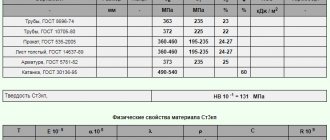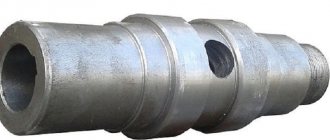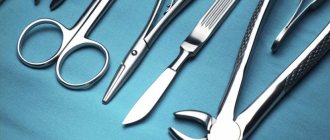Carbon steel of ordinary quality
Carbon steels are divided into three main groups : carbon steels of ordinary quality, high-quality carbon steels and carbon steels for special purposes (automatic steel, boiler room, etc.).
Carbon steels of ordinary quality comply with GOST 380–2005. They are supplied in the form of rolled products in a normalized condition and are used in mechanical engineering, construction and other sectors of the national economy.
Carbon steels of ordinary quality are designated by the letters St and numbers from 0 to 6.
The numbers are the conditional number of the brand. The higher the number, the higher the carbon content, higher the strength and lower the ductility.
Depending on the purpose and guaranteed properties, carbon steels of ordinary quality are supplied in three groups : A, B, C. The indices to the right of the grade number mean:
- kp - boiling;
- ps - semi-calm;
- sp - calm.
The letter G may appear between the index and the brand number; this means a high manganese content. The grade designations to the left of the letters St indicate the groups (B and C) of steel. Ordinary quality steels are divided into categories . The steel category is indicated by the corresponding number to the right of the deoxidation degree index. For example, St5Gps3 means: steel of group A, grade St5, with a high manganese content, semi-calm, third category. Steel of the first category is written without indicating the number of the last, for example St4ps.
The chemical composition of group A steels is not regulated, but their mechanical properties are guaranteed, determined by the relevant state standard. Steels of this group are usually used for parts that are not subjected to hot processing (welding, forging, etc.) during the manufacturing process.
Group B steel is supplied according to its chemical composition and is used for parts that undergo heat treatment and hot pressure treatment (stamping, forging) during the manufacturing process. The mechanical properties of group B steel are not guaranteed. Group B steel is supplied with mechanical properties corresponding to the standards for group A steel, and a chemical composition corresponding to the standards for group B steel. Group B steel is used mainly for welded structures.
Mechanical engineering types
General Purpose Specifications
General purpose structural alloys are divided into two main groups. The first is medium-alloyed and low-alloyed. The second group is medium-carbon and low-carbon.
When producing a general purpose alloy, it is subject to strict testing. Products are monitored and tested for many indicators. Particular attention is paid to the ductility of the material, strength and reliability are checked, and the material is tested for impact strength. Depending on the classification of the metal and the scope of its application, other equally important indicators may be taken into account. There are a lot of them and they are also tested for some important characteristics and properties.
If we consider the first group of medium-alloy and low-alloy, then they are manufactured for machine builders. Such alloys are classified as hypoeutectoid pearlitic steels. For viscosity, these grades use nickel and molybdenum. Such steels include 40KhN2SMA, 40KhGT, 40KhGR, 30Kh3MF, 45KhN2MFA, 25Kh2GNTRA, ZOKHGSN2A, 08Kh15N5D2T
Structural alloys that are produced for the engineering industry can be divided depending on the method of their hardening. Thus, such graded steel can be divided into an alloy with hardening of the top layer, without treatment and with hardening throughout the entire volume.
Many structural steels are used without heat treatment. That is, they are produced and sold to consumers in ordinary sheets of metal. For such products there is one important condition - a minimum amount of carbon and silicon. It is a small amount of silicon and carbon that provides excellent screeding to the material when cold. That is, structural steel easily lends itself to the desired deformation. Among these steels, such grades as St3sp5, 08ps, 08Yu, St20, St30, St40 and others are common.
If high-quality long steel is produced, then in turn it must undergo several heat treatment options: hardening, after which the product can be tempered, standard metal hardening with mandatory tempering (the most effective welding of the finished product), and the last option, normalization.
High-quality carbon steel for structural purposes
High-quality carbon steel for structural purposes complies with GOST 1050–88. differ from ordinary quality steels in having a lower content of sulfur, phosphorus and other harmful impurities, narrower limits of carbon content in each grade and, in most cases, a higher content of silicon and manganese.
Steel is marked with two-digit numbers, which indicate the carbon content in hundredths of a percent, and is supplied with guaranteed chemical composition and mechanical properties. The letter G in the grades of these steels also indicates a high manganese content (up to 1%). High-quality carbon steel is supplied rolled, forged, calibrated, round with a special surface finish (silver). Carbon steels for special purposes include steels (GOST 1414–75) with good and increased machinability by cutting (automatic steels). They are intended mainly for the production of mass-produced parts.
Automatic steels with high sulfur and phosphorus content have good machinability. Cutting machinability is also improved by introducing technological additives into steel - selenium, lead, tellurium. Automatic steels are marked with the letter A and numbers showing the average carbon content in hundredths of a percent. The following grades of automatic steel are used: A12, A20, A30, A40G. Non-critical parts are made from A12 steel, and more critical parts that operate under significant stresses and high pressures are made from steels of other grades. The range of free-cut steel includes the production of long products in the form of bars of round, square and hexagonal sections.
Sheet steel (boiler rooms, GOST 5520–79 and TU) for boilers and pressure vessels is used for the manufacture of steam boilers, ship furnaces, combustion chambers of gas turbines and other parts. They must operate at variable pressures and temperatures up to 450°C. In addition, boiler steel must be weldable well. To obtain such properties, a technological additive (titanium) is introduced into carbon steel and additionally deoxidized with aluminum. The following grades of carbon boiler steel are produced: 12K, 15K, 16K, 18K, 20K, 22K with a carbon content of 0.08 to 0.28%. These steels are supplied in the form of sheets up to 200 mm thick and forgings in the condition after normalization and tempering. The properties and purpose of high-quality structural steels are given in table. 1.
The difference between carbon steels and alloy steels
US grades distinguish between technological processes and the use of various additives. So what is the difference between carbon steels and alloy steels if elements are also added to these iron alloys that change the mechanical, operational and technological parameters:
- Carbon iron alloys contain iron, carbon and normal impurities, which can be beneficial or harmful. The first include manganese and silicon. Harmful impurities are sulfur and phosphorus.
- The material does not contain alloying additives that change properties, such as molybdenum, titanium, tungsten and others.
- CS are not intended for special use; it is a general industrial material.
- Compared to alloyed materials, carbon alloys have lower technological and operational parameters, including hardness and heat resistance.
Influence of alloying elements. Marking of alloy steels
To improve the physical, chemical, strength and technological properties of steel, they are alloyed by introducing various alloying elements into their composition (chrome, manganese, nickel, etc.). Steels may contain one or more alloying elements that give them special properties.
Table 1. Mechanical properties of high-quality structural steel
steel grade | Limit strength when stretched σВ, MPa | Relative elongation δ,% | Hardness, HB | Purpose |
| 08 | 330 | 33 | 131 | Lightly loaded parts: gears, sprockets, rollers, axles subject to carburization |
| 10 | 340 | 31 | 143 | |
| 15 | 380 | 27 | 149 | |
| 20 | 420 | 25 | 163 | |
| 25 | 460 | 23 | 170 | Medium-loaded parts: gears, shafts, axles |
| 30 | 500 | 21 | 179 | |
| 35 | 540 | 20 | 207 | |
| 40 | 580 | 19 | 217 | Medium-loaded parts: connecting rods, shafts, gears, pins |
| 45 | 610 | 16 | 229 | |
| 50 | 640 | 14 | 241 | Highly loaded parts: gears, couplings, circlips, springs |
| 55 | 660 | 13 | 255 | |
| 60 | 690 | 12 | 255 | Springs, springs, eccentrics and other parts operating under friction conditions |
| 65 | 710 | 10 | 255 | |
| 70 | 730 | 9 | 269 | |
| 75 | 1100 | 7 | 285 | |
| 80 | 1100 | 6 | 285 | |
| 85 | 1150 | 6 | 302 | |
| 60G | 710 | 11 | 269 | |
| 70G | 800 | 8 | 285 |
The main structural component in structural steel is ferrite , occupying at least 90% by volume in the structure. By dissolving in ferrite, alloying elements strengthen it.
The hardness of ferrite (in the state after normalization) is most strongly increased by silicon, manganese and nickel - elements with a lattice different from the -Fe lattice. Molybdenum, tungsten and chromium have a weaker effect. Most alloying elements, while strengthening ferrite and having little effect on ductility, reduce impact strength (with the exception of nickel). At levels up to 1%, manganese and chromium increase toughness . Above this content, toughness decreases, reaching the level of unalloyed ferrite at 3% Cr and 1.5% Mn.
An increase in the structural strength when alloying steel is facilitated by an increase in hardenability . Improving the hardenability of steel is achieved by alloying it with several elements, for example Cr + Mo, Cr + Ni, Cr + Ni + Mo and other combinations of various elements.
The high structural strength of steel is ensured by the rational content of alloying elements in it. Excessive alloying after the required hardenability has been achieved leads to a decrease in toughness and facilitates the destruction of steel.
Chromium has a beneficial effect on the mechanical properties of structural steel. It is introduced into steel in amounts up to 2%; it dissolves in ferrite and cementite.
Nickel is the most valuable alloying element. It is introduced into steel in an amount from 1 to 5%.
Manganese is added to steel up to 1.5%. It is distributed between ferrite and cementite. Nickel significantly increases the yield strength of steel, but makes it sensitive to overheating. In this regard, to refine the grain, carbide-forming elements are introduced into the steel simultaneously with nickel.
Silicon is a non-carbide-forming element, and its amount in steel is limited to 2%. It significantly increases the yield strength of steel and, at a content of more than 1%, reduces viscosity and increases the cold brittleness threshold.
Molybdenum and tungsten are carbide-forming elements that are mostly soluble in cementite. Molybdenum in an amount of 0.2...0.4% and tungsten in an amount of 0.8...1.2% in complex alloy steels contribute to grain refinement, increase hardenability and improve some other properties of steel.
Vanadium and titanium are strong carbide-forming elements that are added in small quantities (up to 0.3% V and 0.1% Ti) to steels containing chromium, manganese, and nickel for grain refinement. An increased content of vanadium, titanium, molybdenum and tungsten in structural steels is unacceptable due to the formation of special carbides that are difficult to dissolve when heated. Excess carbides, located along grain boundaries, promote brittle fracture and reduce the hardenability of steel.
Boron is introduced to increase hardenability in very small quantities (0.002...0.005%).
The grade of high-quality alloy steel consists of a combination of letters and numbers indicating its chemical composition. Alloying elements have the following designations (GOST 4543–71):
- chrome (X),
- nickel (N),
- manganese (G),
- silicon (C),
- molybdenum (M),
- tungsten (B),
- titanium (T),
- aluminum (U),
- vanadium (F),
- copper (D),
- boron (P),
- cobalt (K),
- niobium (B),
- zirconium (Z).
The number after the letter indicates the content of the alloying element as a percentage. If the figure is not indicated, then the alloying element contains up to 1.5%.
In high-quality structural alloy steels, the first two digits of the grade indicate the carbon content in hundredths of a percent. High-quality alloy steels have the letter A at the end of the grade, and especially high-quality steels have the letter Ш. For example, steel grade 30ХГСН2А: high-quality alloy steel contains 0.30% carbon, up to 1% chromium, manganese, silicon and up to 2% nickel; steel grade 95Х18Ш: especially high-quality, smelted by electroslag remelting with vacuum, contains 0.9...1.0% carbon; 17...19% chromium, 0.030% phosphorus and 0.015% sulfur. Alloyed structural steels are divided into case-hardened , tempered and high-strength .
Case-hardened, temperable and high-strength steels
Case-hardened steels are low-carbon (up to 0.25 C), low- (up to 2.5%) and medium-alloyed (2.5...10% total content of alloying elements) steels. They are intended for machine parts and devices operating in friction conditions and experiencing shock and variable loads.
Steel grade 15ХА with a tensile strength σ in MPa is intended for the manufacture of small parts operating under friction conditions at medium pressures and speeds. For the manufacture of critical parts operating at high speeds, high pressures and shock loads, steel grades 18ХГ and 25ХГМ . For large, critical, heavily loaded parts, steels 20ХН and 20Х2Н4А .
In the manufacture of large, especially critical, heavily loaded parts operating at high speeds with the presence of vibration and dynamic loads, steel with a tensile strength in MPa grade 18Х2Н4МА .
The performance of such parts depends on the properties of the core and surface layer of the metal. Case-hardening steels are saturated with carbon from the surface (cemented) and subjected to heat treatment (hardening and tempering). This treatment provides high surface hardness (HRC 58...63) and maintains the required toughness and specified strength of the metal core.
Improved alloy steels are medium-carbon (0.25...0.6% C) and low-alloy steels. To ensure the necessary properties (strength, ductility, toughness), these steels are thermally improved by hardening and high tempering (at 500...600°C).
Improved and case-hardening steels after heat treatment give strength up to σ in MPa and toughness up to KS= 0.8...1.0 MJ/m2. Such strength is not enough to create new modern machines. Steels with a strength limit of σ in MPa are required. For these purposes, complex alloyed and maraging steels are used. The properties of such steels and their purpose are shown in table. 2.
Table 2. Improved alloy steels
| Brand | Limit strength at stretching _ σв, MPa | Relative elongation δ,% | Specific viscosity KS, MJ/m2 | Purpose |
| 40ХС | 1250 | 12 | 0,35 | Some parts operating under conditions of increased stress and alternating loads |
| 40HFA | 900 | 10 | 0,9 | |
| 30HGFA | 1100 | 10 | 0,5 | Parts operating under friction conditions and critical welded structures operating under alternating loads and temperatures up to 200°C |
| 40ХН2МА | 1100 | 12 | 0,8 | Large, critical, heavily loaded parts with complex shapes |
Complex alloy steels are medium-carbon (0.25...0.6% C) alloy steels that are heat-strengthened during low tempering or subjected to thermomechanical treatment.
Maraging steels are a new class of high-strength alloy steels based on carbon-free (no more than 0.03% C) alloys of iron with nickel, cobalt, molybdenum, titanium, chromium and other elements. Maraging steels are hardened in air from 800...860°C, followed by aging at 450...500°C.
Carbon and alloy steels (page 1 of 2)
ABSTRACT
on the topic: “Carbon and alloy steels”
Carbon steel is an alloy of iron and carbon (carbon content up to 2%) with impurities of silicon, sulfur and phosphorus, and the main component that determines the properties is carbon. The percentage of elements in steel is approximately the following: Fe - up to 99.0; C - 0.05-2.0; Si – 0.15-0.35; Mn – 0.3-0.8; S – up to 0.06; P – up to 0.07. Depending on the carbon content, carbon steels are divided into low-carbon (up to 0.25% C), medium-carbon (0.25-0.6% C) and high-carbon (more than 0.6% C). There are carbon steels of ordinary quality and high-quality structural ones. The first group includes hot-rolled (sectioned, shaped, thick-sheet, thin-sheet, broad-sheet) and cold-rolled (thin-sheet) steel; the second includes hot-rolled and forged billets with a diameter (or thickness) of up to 250 mm, calibrated steel and silver. Carbon steel is the most common type of ferrous metal.
Structural
carbon steel is steel containing up to 0.65-0.70% carbon (as an exception, structural steels containing 0.85% carbon are produced). Structural steel is used for the manufacture of machine parts and structures. It must have sufficient strength, resist shock well and at the same time be well processed.
Based on quality, structural steel is divided into three groups:
- ordinary quality;
— improved quality;
- high quality.
Ordinary quality steel is widely used steel, used for building structures, fasteners, rolled sheets, rivets, pipes, fittings, bridges, rolled profiles.
High quality steel is used for locomotive and carriage axles, tires, boilers, wire, etc.
High-quality steel is used for parts that require higher ductility, impact resistance, operating at high pressures: for gears, pipes, screws, bolts, for parts subject to carburization, for welded products.
Instrumental
Carbon steel is steel with a carbon content of 0.7% or higher. This steel is characterized by high hardness and strength and is used to make tools. Tool carbon steel is divided into high-quality and high-quality. The content of sulfur and phosphorus in high-quality tool steel is 0.03% and 0.035%, in high-quality tool steel it is 0.02% and 0.03%, respectively.
Produced in accordance with GOST 1435-90 of the following grades: U7; U8; U8G; U9; U10; U11; U12; U13; U7A; U8A; U8GA; U9A; U10A; U11A; U12A; U13A. The standard applies to carbon tool hot-rolled, forged, calibrated steel, and silver.
The group of high-quality steels includes steel grades without the letter A; the group of high-quality steels, purer in sulfur and phosphorus content, as well as impurities of other elements, includes steel grades with the letter A. The letters and numbers in the designation of these steel grades mean: U - carbon, the number following it is the average carbon content in tenths of a percent, G is the increased manganese content.
Applications of Carbon Steel Tools
| U7, U7A | For processing wood: axes, cleavers, chisels, chisels; small pneumatic tools: chisels, crimpers, strikers; forging dies; needle wire; plumbing tools: hammers, sledgehammers, bits, screwdrivers, combination pliers, needle-nose pliers, side cutters, etc. |
| U8, U8A, U8G, U8GA, U9, U9A | For the manufacture of tools operating in conditions that do not cause heating of the cutting edge; wood processing: milling cutters, countersinks, forgings, axes, chisels, chisels, longitudinal and circular saws; knurling rollers, plates and cores for injection molds of tin-lead alloys. For plumbing and assembly tools: crimpers for rivets, punches, bits, screwdrivers, combination pliers, needle-nose pliers, side cutters. For calibers of simple shape and lower accuracy classes; cold-rolled heat-treated strip with a thickness of 2.5 to 0.02 mm, intended for the manufacture of flat and twisted springs and spring parts of complex configurations, valves, probes, reeds, lamellas of splitting knives, structural small parts, including for watches, etc. d. |
| U10A, U12A | For heart patients. |
| U10, U10A | For needle wire. |
| U10, U10A, U11, U11A | For the manufacture of tools operating in conditions that do not cause heating of the cutting edge; wood processing: hand saws and carpentry saws, machine carpentry saws, spiral drills; cold stamping dies (drawing, heading, trimming and cutting) of small sizes and without sharp transitions in cross-section; calibers of simple shape and lower accuracy classes; knurling rollers, files, bench scrapers, etc. For files, scrapers of cold-rolled heat-treated tape with a thickness of 2.5 to 0.02 mm, intended for the manufacture of flat and twisted springs and spring parts of complex configurations, valves, probes, reeds, lamellas of splitting knives , structural small parts, including for watches, etc. |
| U12, U12A | For hand taps, files, metalwork scrapers; dies for cold stamping of cut and die cut small sizes and without cross-sectional transitions, cold heading punches and stamps of small sizes, gauges of simple shape and reduced accuracy classes. |
| U13, U13A | For tools with reduced wear resistance at moderate and significant specific pressures (without heating the cutting edge); files, razor blades and knives, sharp surgical instruments, scrapers, engraving instruments. |
Disadvantages of carbon steel include:
— lack of a combination of strength and hardness with plasticity;
— loss of hardness and cutting ability when heated to 200°C and loss of strength at high temperatures;
— low corrosion resistance in an electrolyte environment, in aggressive environments, in the atmosphere and at high temperatures;
— low electrical properties;
— high coefficient of thermal expansion;
- an increase in the weight of products, an increase in their cost, and a complication of design due to the low strength of this steel.
Alloy steels:
Alloyed steel is a steel in which, along with the usual impurities, there are alloyed elements that dramatically improve its properties: chromium, tungsten, nickel, vanadium, molybdenum, etc., as well as silicon and manganese in large quantities. Impurities are introduced during the smelting process.
According to the chemical composition (GOST 5200), alloy steel is divided into three groups:
— low-alloy steel – no more than 2.5% impurities;
- medium alloyed - 2.5-10%;
– highly alloyed – over 10%.
Alloy steel has valuable properties that carbon steel does not have, and does not have its disadvantages. The use of alloy steel increases the durability of products, saves metal, increases productivity, simplifies design, and therefore becomes crucial in advanced technology. According to their purpose, alloy steels are usually divided into structural steels, tool steels and steels with special properties (electrical, stainless, heat-resistant, etc.).
Structural
Alloy steel is divided into high-quality, high-quality A and especially high-quality Sh (electroslag remelting).
Depending on the main alloying elements, this steel is divided into groups:
Chromium steel has a very wide range of applications. Chromium has a positive effect and is an inexpensive impurity. Steel grades 15Х, 20Х, 30ХА are used for parts in the automotive and tractor industries. Chromium steels with a high content of carbon (0.9-1.1%) and chromium (0.8-1.65%) are used for the manufacture of rings, balls and rollers of ball bearings. Their brands: ShKh6, ShKh9, ShKh15SG, ShKh10. They have good hardness.
Manganese steel, after appropriate chemical and thermal treatment, acquires high hardness without reducing ductility. Processes better than carbon. Steel grades 15G, 20G, 30G, etc. are widely used in production. High wear resistance.
Chromium-nickel steel is one of the most common structural steels, since after heat treatment it acquires high hardness, strength, elasticity and resistance to impact loads; its brands are 20ХНА, 12Х2Н4А, 12ХН3А
Chrome-silicon steel has high hardness and elasticity after heat treatment and is widely used for the manufacture of springs and springs.
Chromium-manganese steel partially replaces chromium-nickel steel (in order to save nickel). Steel grades 20KhG, 20KhGR, 40KhGR, 30KhSS, 18KhGT are widely used; the latter goes for car parts.
Chromium-manganese-silicon steel (chromansil) is a substitute for chromium-molybdenum steels. With a low carbon content, it is easily stamped and welded. Brand - 25ХGSD, 14ХГСА, 30ХГСА.
Chrome vanadium steel has high strength, ductility, hardness, and elasticity. Steel grade 50ХВА is used for critical springs, grade 15ХФ is used for shafts, gears, and couplings.
Chrome-molybdenum steel has high ductility and good weldability; many of these steels are heat-resistant at temperatures of 400-500°C. Steel grade 30ХМА is used for the manufacture of rotors, axles, and gears.
Chromium-nickel-tungsten and chromium-nickel-molybdenum steels are intended for loaded machine parts, gears, crankshafts, and highly loaded connecting rods. The grades of this steel are 30KhNVA, 40KHNVA, 40KHNMA, 25KH2N4VA.
Instrumental
alloy steel. This steel is used for the manufacture of various tools: impact-stamping, measuring, cutting. It has a number of advantages over tool carbon steel. Carbon steel dies have high hardness and strength, but have poor impact resistance. Taps, reamers and other long and thin tools made of carbon steel become brittle when hardened, they are unreliable in operation and often break.
Carbon tool steels
Tool steels are a special group of steels with specific properties. These steels are intended for the manufacture of cutting and measuring tools and dies.
requirements are imposed on carbon tool steels :
- steels for cutting tools (cutters, drills, taps, milling cutters, etc.) must have high hardness, wear resistance and heat resistance;
- steels for measuring instruments must be hard, wear-resistant and retain the dimensions and shape of the instrument for a long time;
- steels for dies (cold and hot deformation) must have high mechanical properties (hardness, wear resistance, toughness) that are preserved at elevated temperatures;
- Steels for hot deformation dies must be resistant to the formation of surface cracks during repeated heating and cooling.
Tool carbon steels (GOST 1435–99) are produced in the following grades: U7, U8, U8G, U9, U10, U11, U12 and U13. The numbers indicate carbon content in tenths of a percent. The letter G, for example U8G, after the number means that the steel has a high manganese content, which ensures greater hardness of the alloy.
The grade of high-quality tool carbon steel has the letter A, for example U12A: high-quality tool carbon steel containing 1.2% C. Tools whose use is associated with impact loads, for example chisels, bits, hammers, are made from steels U7A, U8A . Tools that require great hardness but are not subject to impact, such as drills, taps, reamers, scrapers, files, are made from steels U12A, U13A . Steels U7-U9 are subjected to complete hardening, and steels U10-U13 are subjected to incomplete hardening.
The disadvantage of carbon tool steels is their low heat resistance - the ability to maintain greater hardness at high heating temperatures. When heated above 200°C, tools made of carbon steels lose hardness, i.e. at elevated temperatures it is necessary to use tools made of other steels.
Scope of application of carbon steels
The scope of application of the control system is determined by the type. Thus, low-carbon steel is used for cold deformation and hot forging; its grades are characterized by high ductility. Iron alloys with an average carbon content differ slightly in terms of fluidity and ductility, but its strength is already higher. They are relevant for the production of structural elements and mechanisms that will be used under normal conditions. CWs with a high carbon content have high strength; various tools and measuring instruments are made from them. Standard quality control is used in the production of sheet material, channels, rods, beams and other products. Machine elements and metal structures are made from it.
Alloy tool steels
Alloyed tool steels have GOST 5950–2000. Alloying elements introduced into tool steels increase heat resistance (tungsten, molybdenum, cobalt, chromium), hardenability (manganese), toughness (nickel), wear resistance (tungsten). Compared to carbon alloy tool steels, they have the following advantages :
- good hardenability;
- high ductility in the annealed state;
- significant strength in the hardened state, higher cutting properties.
Low-alloy tool steels contain up to 2.5% alloying elements, have high hardness (HRC 62...69), significant wear resistance, but low heat resistance (200...260°C). They are used to make tools of more complex shapes. In low-alloy steels X, 9ХС, ХВГ, ХВСГ, the main alloying element is chromium . Steel X is alloyed with chromium only. The increased chromium content increases its hardenability. Steel X is calcined in oil completely in a section up to 25 mm, steel U10 - only in a section up to 5 mm.
X steel is used for the manufacture of turning, planing and slotting tools. Steel 9ХС , in addition to chromium, is alloyed with silicon. Compared to steel X, it has greater hardenability - up to 35 mm; increased heat resistance - up to 250...260°C (steel X - up to 200...210°C) and better cutting properties. Drills, reamers, cutters, taps, and dies are made from 9ХС steel. HVG steel is alloyed with chromium, tungsten and manganese ; has hardenability to a depth of 45 mm. HVG steel is used for the production of large and long broaches, long taps, long reamers, etc.
KhVSG steel is a complex alloy and, in comparison with 9ХС and KhVG steels, is better hardened and calcined. When cooled in oil, it is completely calcined in a cross section of up to 80 mm. It is less sensitive to overheating. Its heat resistance is the same as that of 9XC steel. HVSG is used for the manufacture of round dies, reamers, large broaches and other cutting tools.
High-alloy tool steels contain tungsten, chromium and vanadium in large quantities (up to 18% of the main alloying element); have high heat resistance (600...640°C). They are used to manufacture high-performance cutting tools designed for processing high-strength steels and other difficult-to-cut materials. Such steels are called high-speed (GOST 19265–73). High-speed steels are designated by the letter P, the number after which indicates the tungsten content. The content of chromium (4%) and vanadium (2%) in high-speed steel grades is not indicated. Some high-speed steels additionally contain molybdenum, cobalt and large amounts of vanadium. The grades of such steels contain, respectively, the letters M, K, F and numbers indicating their quantity. For the manufacture of measuring instruments, X, HVG and other steels are used, the chemical composition of which is given in GOST 5950–2000.
For a measuring tool, the change in dimensions of a hardened tool over time is of great importance. Therefore, when heat treating a measuring instrument, attention is paid to stabilizing the stress state. This is achieved by low tempering mode - at a temperature of 120...130°C for 15...20 hours and processing at temperatures below zero (down to –60°C).
Cold deformation dies of small size (25...30 mm cross-section), simple shape, working in light conditions, are made from carbon steels U10, UN, U12. Dies with a cross section of 75...100 mm of more complex shape and for more severe working conditions are made from steels of increased hardenability X, KhVG. To produce tools with high hardness and increased wear resistance , as well as low deformability during hardening, steels with high hardenability and wear resistance are used, for example high-chromium steel Kh12F1 (11...12.5% Cr; 0.7...0.9% V).
For tools that are exposed to high impact loads (such as pneumatic chisels, cutting knives for cold metal cutting shears), steels with a lower carbon content and high viscosity are used - 4ХС, 6ХС, 4ХВ2С, etc.
Hot deformation hammer dies are made from steels 5ХНМ, 5ХГМ, 5ХНВ. These steels contain the same amount (0.5...0.6%) of carbon and are alloyed with chromium. This carbon content makes it possible to obtain a fairly high impact strength; chromium increases the strength and hardenability of steels. Nickel is introduced into these steels to increase toughness and improve hardenability. Tungsten and molybdenum increase hardness and heat resistance, reduce brittleness, refine grain, and reduce the tendency of steel to overheat. Manganese, as a cheaper alloying element, is a substitute for nickel. Hammer die steels are characterized by deep hardenability .
Heat-resistant and heat-resistant steels
The interaction of the metal with the environment as the temperature rises causes gas corrosion (oxidation) and destruction of the material. For the manufacture of parts operating at elevated temperatures (400...900°C) and oxidation in a gas environment, special heat-resistant steels .
Heat resistance ( or scale resistance) refers to the ability of a material to resist corrosion damage at high temperatures.
Heat-resistant steels include steels containing aluminum, chromium, and silicon (Table 4). They do not form scale at high temperatures. For example, chromium steel containing 30% Cr is stable at temperatures up to 1200°C. The introduction of small additions of aluminum dramatically increases the heat resistance of chromium steels. The resistance of such materials at high temperatures is explained by the formation on their surface of dense protective films consisting of oxides of alloying elements (chromium, aluminum, silicon).
Table 4. Heat-resistant steels
| Brand | Operating temperature, °C | Purpose GOST 5632–72 |
| 40Х9С2 | 850 | Valves of internal combustion engines |
| 08Х17Т | 900 | Parts operating in flue gases with high sulfur content |
| 36Х18Н25С2 | 1100 | Nozzles and flame tubes of gas turbine units |
Scope of application of heat-resistant steels:
- production of various parts of heating devices;
- production of power plants.
Thus, valves of internal combustion engines are made of steel 40Х9С2 with an operating temperature of no more than 850°С, and nozzles and flame tubes of gas turbine units are made of steel 36Х18Н25С2 with a maximum operating temperature of 1100°С.
For the manufacture of machine parts that operate for a long time at heavy loads and high temperatures (500...1000°C), special heat-resistant steels .
Heat resistance is the ability of a material to withstand mechanical loads without significant deformation at high temperatures. Heat-resistant steels include those containing chromium, silicon, molybdenum, nickel, etc. They retain their strength properties when heated to 650°C or more (Table 5). Such steels are used to make heating elements of heat exchange equipment, boiler parts, inlet and outlet valves of automobile and tractor engines.
Table 5. Heat-resistant steels
| Brand GOST 5632–72 | Operating temperature, °C | Purpose |
| 45Х14Н14В2М | 800—900 | Valves of high power internal combustion engines |
| 08Х16Н13М2Б | 600—700 | Gas turbine blades |
Magnetic and soft magnetic steels and alloys
Depending on the coercive force and magnetic permeability, magnetic steels and alloys hard magnetic and soft magnetic .
Magnetically hard steels and alloys are used for the manufacture of permanent magnets; they have a high coercive force. These are high-carbon and alloy steels, special alloys.
Carbon steels (U10-U12) after hardening have sufficient coercive force (Hc = 5175 A/m), but since they are calcined to a shallow depth, they are used for the manufacture of small magnets.
Chromium steels are calcined much deeper than carbon steels, which is why larger magnets are made from them. The magnetic properties of these steels are the same as those of carbon steels.
Chromium-cobalt steels (for example, grade EX5K5) have a higher coercive force Hc = 7166 A/m. Magnetic alloys, for example, UNDK24 (9% Al, 13.5% Ni; 3% Cu; 24% Co; the rest is iron), have a very high coercive force Hc = 39,810 A/m, so small magnets are made from them , but high power.
Soft magnetic steels and alloys have low coercivity and high magnetic permeability. These include electrical iron and steel , iron-nickel alloys (permalloy).
Electrical iron (grades E, EA, EAA) contains less than 0.04% C, has a high magnetic permeability μ = (2.78/3.58)·109 GH/m and is used for cores, pole pieces of electromagnets, etc.
Electrical steel contains less than 0.05% C and silicon, which greatly increases magnetic permeability. Electrical steel is divided into four groups based on silicon content: with 1% Si - grades E11, E12, E13; with 2% Si - E21, E22; with 3% Si - E31, E32; with 4% Si - E41-E48. The second number (1-8) characterizes the level of electrical properties.
Iron-nickel alloys (permalloy) contain 45...80% Ni, they are additionally alloyed with Cr, Si, Mo. The magnetic permeability of these alloys is very high. For example, for permalloy grade 79NM (79% Ni; 4% Mo) μ = 175.15·109 GGN/m. Permalloys are used in equipment operating in weak electromagnetic fields (telephone, radio).
Ferrites are magnetically soft materials obtained by sintering a mixture of ferromagnetic iron oxide Fe2O3 powders and divalent metal oxides (ZnO, NiO, MgO, etc.). Unlike other soft magnetic materials, ferrites have a very high electrical resistivity, which determines their use in devices operating at high and ultrahigh frequencies.
Classification of alloy steels
Classification and marking of alloy steels is carried out according to several parameters.
By quality
Depending on the amount of harmful impurities (sulfur, phosphorus), alloy steels are high-quality (S≤0.04%, P≤0.035%), high-quality (S≤0.025%, P≤0.025%), especially high-quality: (S≤0 .06%, P≤0.07%).
By number of additives
Depending on the total amount of additives, the following types of alloy steel are distinguished:
- High alloy steel: 10-50% alloying additives. The products are the most durable, but also the most expensive.
- Medium alloyed: 2.5-10% additives. These are the most popular brands.
- Low alloy: additives no more than 2.5%. Positive qualities improved, but did not noticeably affect metalworking.
Depending on the chemical composition, steels are called: chromium, chromium-nickel, chromium-nickel-molybdenum, manganese and others. In the marking they are indicated by the corresponding letters.
By purpose
According to practical application, steels are classified into structural (machine-building, construction, improvement, cemented), tool (for dies, cutting and measuring tools) and with special properties.
Wear-resistant steels
Alloys with high electrical resistance, with a specified coefficient of thermal expansion and specified elastic properties
For the manufacture of machine parts operating under friction conditions, special wear-resistant steels - ball bearing, graphitized and high-manganese.
Ball bearing steels (ШХ6, ШХ9, ШХ15) are used for the manufacture of balls and bearing rollers. In terms of their chemical composition (GOST 801–78) and structure, these steels belong to the class of tool steels. They contain about 1% Cu, 0.6...1.5% Cr.
Graphitized steel (high-carbon steel, containing 1.5...2% C and up to 2% Cr) is used for the manufacture of piston rings, pistons, crankshafts and other shaped castings operating under friction conditions. Graphitized steel after hardening combines the properties of hardened steel and gray cast iron.
High-manganese steel G13L, containing 1.2% C and 13% Mn, is used for the manufacture of railway crosses, track links, etc. This steel has maximum wear resistance when it has a single-phase austenite structure, which is ensured by hardening (at a temperature of 1000...1100°C) while cooling in air.
Alloys with high electrical resistance are used for the manufacture of electric heaters and resistance elements and rheostats. Alloys for electric heaters have high heat resistance, high electrical resistance, and satisfactory ductility in the cold state. These requirements are met by iron-chromium-aluminum alloys, for example, grades Kh13Yu4 (≤ 0.15% C; 12...15% Cr; 3.5...5.5% A1), 0Kh23Yu5 ≤ 0.05% C; 21.5…23.5% Cr; 4.6...5.3% A1); and nickel alloys, for example, grades X15N60 - ferronichrome containing 25% Fe, X20H80 - nichrome.
Alloys with a given coefficient of thermal expansion contain large amounts of nickel. Alloy 36N, called invar (≤ 0.05% C and 35...37% Ni), hardly expands at temperatures from –60 to +100°C. It is used for the manufacture of device parts that require constant dimensions within the range of climatic temperature changes. Alloy 29NK, called kovar (≤ 0.03% C; 28.5...29.5% Ni; 17...18% Co), has a low coefficient of thermal expansion in the temperature range from –70 to +420°C.
Alloys with specified elastic properties include alloy 40KKhNM (0.07...0.12% C; 15...17% Ni; 19...21% Cr; 6.4...7.4% Mo, 39...41% Co). This is a high-strength alloy with high elastic properties, non-magnetic, corrosion-resistant in aggressive environments.
